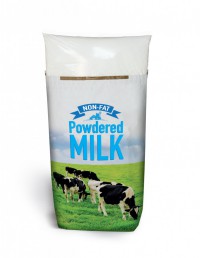CEPI Eurokraft , EUROSAC Catherine Kerninon - General Delegate
Convincing arguments for paper sacks for food
Numerous requirements in terms of hygiene, handling and storage practices have to be taken into account when packaging food products. The European paper sack and sack kraft paper industry has contributed many developments that make paper sacks a perfect packaging for food.
In the food sector, paper sacks are mainly used to transport powdery products such as sugar, flour, starch, food additives, aromatic herbs, processed or dried fruit, eggs or milk. They are typically constructed as open mouth or valve sacks, and consist of two to three layers of paper, often in combination with a polyethylene (PE) free film tube inliner and/or coated paper. They use starch-based glue and water-based inks in order to avoid contamination risks. Some food products such as flour or starch need to interact with air and moisture to prevent mould formation. Paper sacks are the best solution for these products. Thanks to their natural porosity, paper sacks enable the products to “breathe”. The air can escape from the sack while at the same time protecting the contents securely from outside influences. This allows for an economic filling process as well as easy palletization. Paper also vents minor amounts of moisture so that no condensed moisture may occur inside the sacks.
All relevant EU regulations are fulfilled
The fibres used to produce sack kraft paper are 100 % natural and renewable. Thus, when using paper as packaging material, fillers choose the environmentally friendly solution that can also be recycled and composted at the end of their life. “When producing paper sacks for food, producers face a large number of legal requirements that ensure hygiene and prevent any possible harm to health,” explains Catherine Kerninon, General Delegate of Eurosac, the European Federation of Multiwall Paper Sack Manufacturers. “Any food sack supplier should be certified by an independent accredited body according to the EU-wide safety standards for suppliers of food packaging.”
Besides compliance with national and EU-wide rules and laws, the producers have to run migration tests and fulfil a hazard analysis and critical control points concept (HACCP). This includes, for example, protecting paper from moisture and mould, especially in warehousing; periodically checking glues used for joints and closure in order to prevent contamination risk from bacteria; and analyzing risk of contamination from foreign material that might migrate during sack manufacture.
Customers have their own requirements and audits. These may range from a further reduction of hygienic risks, for example in regard to procedures in the production area, sack closure, palletizing and handling issues to the overall environmental and ethical performance along the supply chain. “The food industry achieves continuous improvements thanks to internal and external regulations,” says Catherine Kerninon. “This leads the packaging producers to a consistent update on materials, technology and product innovation.” All sack kraft paper qualities from the main suppliers fulfil the relevant EU regulations and are transported in an adequate wrapping of protective paper to the converters.
Concerning sack construction, many different sealing, barrier and coating concepts have been developed to ensure a tight closure of the sack and to protect the contents from moisture, oxygen, odours or migration of mineral oils, for instance. An example of sack closure is a stepped end-bottom sack with hot melt on the mouth or other types of sealable valves. One of the developments concerning product protection is a hybrid sack with paper outside and an “easy peel” PE inlay inside.•
http://www.eurosac.org http://www.cepi-eurokraft.org




